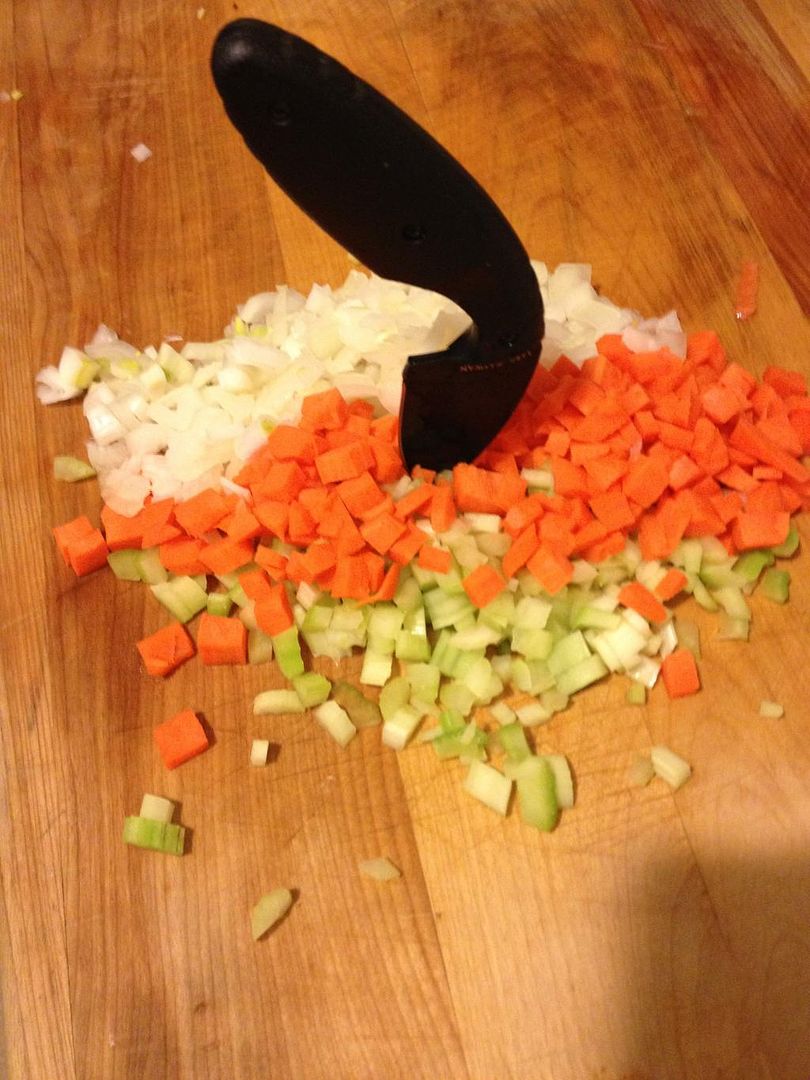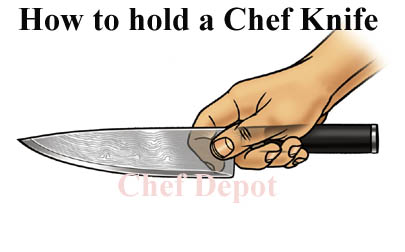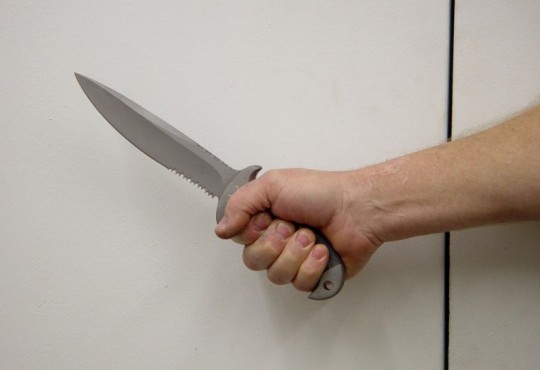|
|
Post by LowKey on Jan 14, 2015 13:40:57 GMT
I'm not really a "fighting knife" type of person. I tend to go with knives that have more utilitarian purposes as their primary function, but that can be pressed into service for cutting someone in the four "classic" ways.* So while staring at my monitor suffering from a bit of work related brain-fry an odd knife related question popped into my head: Why aren't fighting knives shaped like chef's knives?? They've got a nice curved cutting surface for slicing. They're wider than hell, so stab wounds would create a whole lot more carnage than most "fighting knife" designs I've seen.
Beef up the blade a bit, add a cross guard if that's your preference, and you should have one hell of a nasty Pokey-McStabby.
Thoughts?
1-Long 2-Hard 3-Deep 4-Continuously |
|
|
|
Post by Browning35 on Jan 14, 2015 14:21:56 GMT
I believe the main reason is that Kitchen knives are usually really thin and they frequently break at the tip or at the handle after being used to stab with. The tip hits bone and digs in and snaps off or the whole thing gets stuck between ribs and snaps off leaving the user holding just a handle. Ran on a shitload of stabbings and kitchen knives, cheap folders, Phillips screwdrivers and box cutters seem to be the most frequently used knives with kitchen knives being at the top. Once you take care of the construction they make a decent weapon though. Trace Rinaldi makes the T.T.K.K / Talmadge Tactical Kitchen Knife.  |
|
|
|
Post by LowKey on Jan 14, 2015 14:29:36 GMT
Oh, I realized your average chef's knife would be a bit flimsy. Hence my comment about "beef up the blade".
I imagine any wound resulting from an 8inch or larger chef's knife being pushed into the chest or abdomen would be pretty horrid.
|
|
|
|
Post by Browning35 on Jan 14, 2015 15:10:06 GMT
Yeah, I knew you'd already considered it since you said as much. I was just more confirming what you were saying.
The primary purpose of most kitchen knives is for food prep and slicing and chopping and it shows in their design. Most knife makers that market defensive knives are generally going for something that's heavy duty and somewhat evil looking and the looks of a kitchen knife are fairly ordinary looking. They don't end up selling as well.
When large kitchen knives hold up they inflict quite a bit of damage. 3 of my most memorably visual pt's were cut/stabbed with kitchen knives. One mentally ill guy used to stab himself and then call 911 and go to the playground around the corner and wait, every shift got him at least once. Another was this crackhead chick who got her left arm hacked apart fending off her boyfriend with this ginormous butcher knife and the third was this guy who stabbed his mother and then himself and when we got there a great deal of his bowel was exposed.
I actually still have a pic of the first guys wound as it was an impaled object and we had to secure it. We knew that the ER doc would want to see the wound before kicking him upstairs for surgery. Don't know about posting it in an open forum though.
At any rate form follows function and I think that's why you don't see that design a whole lot in defensive knives. Rinaldi's the only one I know of that makes a knife like that.
|
|
|
|
Post by LowKey on Jan 14, 2015 15:51:36 GMT
I get the "form follows function", but I seem to recall a number of very broad bladed fighting knives from antiquity. We're talking about blades that were as wide as the width of your palm near the hilt with varying degrees of taper to the point, maybe around 6-10 inches in length. My fuzzy recollections place those knives in periods/cultures where armor either wasn't used or wasn't particullary heavy duty, leading me to suspect that they passed out of favor not becuase they didn't inflict suffcient wounds but because armor came along and made it more difficult to jam a broad blade in deeply. If you think about it, stilletos are the opposite of that, and stilletos were primarily for punching through medival armor.
|
|
|
|
Post by omegaman on Jan 14, 2015 17:22:49 GMT
Man, I sold my CRKT Hissatu (check my spelling) and regret it now. Looking back, it was the perfect fighting knife. The katana-style upswept blade made for fast and effective slicing, overall thin profile to easily stick deep into cavities, and had a wicked cross-section for a serious puncture wound channel. Knowing what RTF can do with Kydex makes me want one again...bad.
Anyway, knife-fighting is weird. You would think cutting a bitch is just cutting a bitch---which any knife can do. However, killing a mofo requires deep puncture wounds to vital organs--wherein I prefer something that I can get all prison-shank with. Fast, repeated, and deep. Big reason why I just added my Cold Steel Spike back to my rig.
|
|
|
|
Post by dannusmaximus on Jan 14, 2015 17:51:51 GMT
Anyway, knife-fighting is weird. You would think cutting a bitch is just cutting a bitch---which any knife can do. However, killing a mofo requires deep puncture wounds to vital organs--wherein I prefer something that I can get all prison-shank with. Fast, repeated, and deep. Big reason why I just added my Cold Steel Spike back to my rig. Stabbings/slicings are an absolute horror show. Like, jaw-dropping, oh my god look at all that blood oh my god ARE THOSE HIS INTESTINES?!?!? kind of a horror show. Like Omega points out, though, you're ultimately trying to do the same thing with a knife that you are with a gun - - make them bleed to death OR cause a CNS injury that instantly stops them (hard as shit to do with a knife) OR just hurt them enough that they give up. I don't think I've every seen anybody carved up with anything that was designed for that purpose (a fighting style knife), but have seen some awful injuries from things like box cutters, bottles, pieces of metal cans, and plain old kitchen knives. As bad as they are, though, none would have been what I considered immediate fight-stoppers. Some of them would have bled to death in a pretty short amount of time, but a person bleeding to death can still kill you. Knives terrify me. I think I would rather be shot. LowKey, maybe fighting knives aren't designed that way (very wide, long) any more because they simply aren't a primary weapon anymore, not because the design isn't solid. Back in the days of antiquity, a large knife or sword was the state of personal defense art. Not so much anymore. Knives are relegated almost exclusively to backup duty, so carrying a big ass knife on your belt is not worth the hassle. Carrying the equivalent of a butcher knife on your belt would be a huge pain (although kind of bad ass as well...). |
|
|
|
Post by LowKey on Jan 14, 2015 18:28:09 GMT
LowKey, maybe fighting knives aren't designed that way (very wide, long) any more because they simply aren't a primary weapon anymore, not because the design isn't solid. Back in the days of antiquity, a large knife or sword was the state of personal defense art. Not so much anymore. Knives are relegated almost exclusively to backup duty, so carrying a big ass knife on your belt is not worth the hassle. Carrying the equivalent of a butcher knife on your belt would be a huge pain (although kind of bad ass as well...). I was thinking along the lines of the Talmadge Tactical Kitchen Knife B35 posted, just with a wider blade, maybe a 7 or 8 inch blade. Jam that puppy in a few times and I suspect their hydraulic reservoir will run dry in short order. Sharpen it like I do my carbon steel Sabatier and a slash anywhere is going right down to the bone, no question. Fingers would come off like hotdogs meeting a meat cleaver. Hmm..... |
|
|
|
Post by Browning35 on Jan 14, 2015 19:15:26 GMT
LowKey : That sounds about right. In antiquity most of the larger fighting knives like the Seax were about 1.5 inches wide and the daggers being a bit thinner. Coincidentally the early Bowie knifes were about the same size. Large/wide enough to do quite a bit of damage but slim enough to go between the ribs. Both types of knives (Seax and the Bowie) pulled double duty for utility and defense. I believe that both types also started out as ordinary butcher knives. Same thing happened with Green River knives in the early to mid 1800's on the American frontier. Some of the current Bowie knives are ridiculously wide if the manufacturers had self defense in mind.
|
|
|
|
Post by dannusmaximus on Jan 14, 2015 20:03:34 GMT
Fingers would come off like hotdogs meeting a meat cleaver. Hmm..... Good lord, that's a ghastly mental image. |
|
|
|
Post by LowKey on Jan 14, 2015 20:23:47 GMT
Fingers would come off like hotdogs meeting a meat cleaver. Hmm..... Good lord, that's a ghastly mental image. As you might imagine, I'm a blast at dinner parties  |
|
|
|
Post by misterdark on Jan 14, 2015 20:55:41 GMT
Is it bad that I have used a Ka-Bar for food prep?
|
|
|
|
Post by nxp on Jan 14, 2015 21:26:31 GMT
First thing that came to mind when reading a topic about non-traditional fighting knives -  (fantastic movie, BTW, one of my faves) (fantastic movie, BTW, one of my faves)I suppose it was more a question of what you had on hand, vs a dedicated fighting tool (dual edged, thin daggers with minimal lengths to penetrate deeply past armor and/or reach vital structures quickly). |
|
|
|
Post by RTF Squared on Jan 14, 2015 22:15:14 GMT
I've used a Kabar, Glock field knife and all four Kabar TDI's I've ever owned for food prep at some point or another.  Back in my fine dining days I got a great chewing out when I was using a Kabar for shucking mussels by my French chef. It was hilariously worth it. That guy loved to yell. |
|
|
|
Post by scbrian on Jan 15, 2015 0:05:06 GMT
One thing not covered yet (I dont think I saw it anyway) is th way you hold the diffrent knives. Yes, I've used pocket knives, fighting knives, etc for food prep, "They worked" is about the best that can be said about them. You hold a chef knife differently than you do a fighting knife, so the design is built around it:  Vs.  |
|